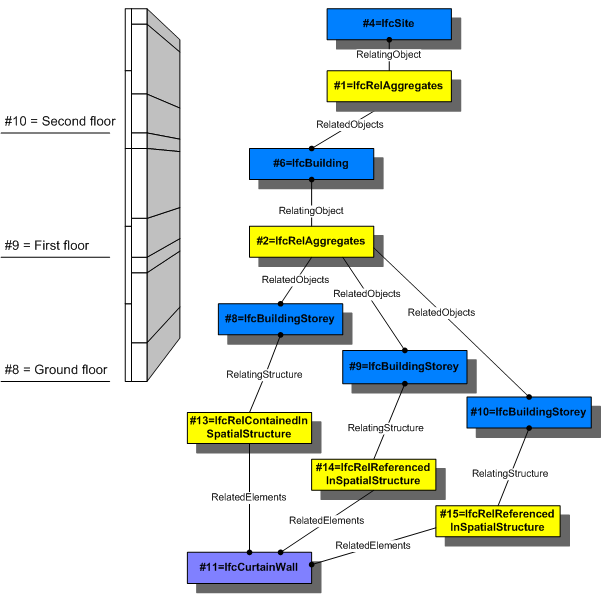Natural language names
 | Bezieht sich auf eine räumliche Struktur - Relation |
 | Rel Referenced In Spatial Structure |
Change log
| Item | SPF | XML | Change | Description | IFC2x3 to IFC4 4.0.0.0 |
|---|---|---|---|---|
| IfcRelReferencedInSpatialStructure | ||||
| OwnerHistory | MODIFIED | Instantiation changed to OPTIONAL. | ||
| RelatingStructure | X | X | MODIFIED | Type changed from IfcSpatialStructureElement to IfcSpatialElement. | IFC4 Addendum 2 4.0.2.0 |
| IfcRelReferencedInSpatialStructure | ||||
| RelatingStructure | X | MODIFIED | Xsdformat changed from Attribute to Hidden. | IFC4x2 to IFC4x3_RC1 |
| IfcRelReferencedInSpatialStructure | ||||
| RelatedElements | MODIFIED | Type changed from IfcProduct to IfcSpatialReferenceSelect. |
Semantic definitions at the entity
Entity definition
The objectified relationship, IfcRelReferencedInSpatialStructure is used to assign elements in addition to those levels of the project spatial structure, in which they are referenced, but not primarily contained. It is also used to connect a system to the relevant spatial element that it serves.
NOTE The primary containment relationship between an element and the spatial structure is handled by IfcRelContainedInSpatialStructure.
Any element can be referenced to zero, one or several levels of the spatial structure. Whereas the IfcRelContainedInSpatialStructure relationship is required to be hierarchical (an element can only be contained in exactly one spatial structure element), the IfcRelReferencedInSpatialStructure is not restricted to be hierarchical.
EXAMPLE A wall might be normally contained within a storey, and since it does not span through several stories, it is not referenced in any additional storey. However a curtain wall might span through several stories, in this case it can be contained within the ground floor, but it would be referenced by all additional stories, it spans.
Predefined spatial structure elements to which elements can be assigned are
- site as IfcSite
- facility as IfcFacility or its subtypes IfcBridge, IfcBuilding, IfcMarineFacility, IfcRailway or IfcRoad
- part of facility as IfcFaciltityPart, or more specifically as IfcBuildingStorey or IfcSpace
Elements can also be references in a spatial zone that is provided as IfcSpatialZone.
Figure 329 shows the use of IfcRelContainedInSpatialStructure and IfcRelReferencedInSpatialStructure to assign an IfcCurtainWall to two different levels within the spatial structure. It is primarily contained within the ground floor, and additionally referenced within the first and second floor.
 |
Figure 329 — Relationship for spatial structure referencing |
HISTORY New entity in IFC2x3.
Attribute definitions
| # | Attribute | Type | Cardinality | Description | G |
|---|---|---|---|---|---|
| 5 | RelatedElements | IfcSpatialReferenceSelect | S[1:?] | X | |
| 6 | RelatingStructure | IfcSpatialElement | X |
Formal Propositions
| Rule | Description |
|---|---|
| AllowedRelatedElements | The relationship object shall not be used to include other spatial structure elements into a spatial structure element. The hierarchy of the spatial structure is defined using IfcRelAggregates. Exception: an IfcSpace can be referenced by another spatial structure element, in particular by an IfcSpatialZone.
IFC4 CHANGE The relaxation to allow IfcSpace has been included. |
Inherited definitions from supertypes
Entity inheritance

Attribute inheritance
| # | Attribute | Type | Cardinality | Description | G |
|---|---|---|---|---|---|
| IfcRoot | |||||
| 1 | GlobalId | IfcGloballyUniqueId | Assignment of a globally unique identifier within the entire software world. | X | |
| 2 | OwnerHistory | IfcOwnerHistory | ? |
Assignment of the information about the current ownership of that object, including owning actor, application, local identification and information captured about the recent changes of the object,
NOTE only the last modification in stored - either as addition, deletion or modification. IFC4 CHANGE The attribute has been changed to be OPTIONAL. | X |
| 3 | Name | IfcLabel | ? | Optional name for use by the participating software systems or users. For some subtypes of IfcRoot the insertion of the Name attribute may be required. This would be enforced by a where rule. | X |
| 4 | Description | IfcText | ? | Optional description, provided for exchanging informative comments. | X |
| IfcRelationship | |||||
| IfcRelConnects | |||||
| IfcRelReferencedInSpatialStructure | |||||
| 5 | RelatedElements | IfcSpatialReferenceSelect | S[1:?] | X | |
| 6 | RelatingStructure | IfcSpatialElement | X | ||
Definitions applying to General Usage
Concept inheritance
| # | Concept | Template | Model View |
|---|---|---|---|
| IfcRoot | |||
| Identity | Software Identity | General Usage | |
| Revision Control | Revision Control | General Usage | |
Formal representations
XML Specification
<xs:element name="IfcRelReferencedInSpatialStructure" type="ifc:IfcRelReferencedInSpatialStructure" substitutionGroup="ifc:IfcRelConnects" nillable="true"/>
<xs:complexType name="IfcRelReferencedInSpatialStructure">
<xs:complexContent>
<xs:extension base="ifc:IfcRelConnects">
<xs:sequence>
<xs:element name="RelatedElements">
<xs:complexType>
<xs:group ref="ifc:IfcSpatialReferenceSelect" maxOccurs="unbounded"/>
<xs:attribute ref="ifc:itemType" fixed="ifc:IfcSpatialReferenceSelect"/>
<xs:attribute ref="ifc:cType" fixed="set"/>
<xs:attribute ref="ifc:arraySize" use="optional"/>
</xs:complexType>
</xs:element>
</xs:sequence>
</xs:extension>
</xs:complexContent>
</xs:complexType>
EXPRESS Specification
ENTITY IfcRelReferencedInSpatialStructure
SUBTYPE OF (IfcRelConnects);
RelatedElements : SET [1:?] OF IfcSpatialReferenceSelect;
RelatingStructure : IfcSpatialElement;
WHERE
AllowedRelatedElements : SIZEOF(QUERY(temp <* RelatedElements | ('IFCPRODUCTEXTENSION.IfcSpatialStructureElement' IN TYPEOF(temp)) AND (NOT ('IFCPRODUCTEXTENSION.IfcSpace' IN TYPEOF(temp)))
)) = 0;
END_ENTITY;
 References: IfcGroup
IfcProduct
IfcSpatialElement
IfcSystem
References: IfcGroup
IfcProduct
IfcSpatialElement
IfcSystem

 EXPRESS-G diagram
EXPRESS-G diagram Link to this page
Link to this page